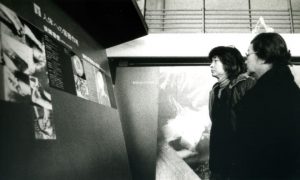Photographs of Seiji Ozawa in Peace Memorial Museum found, showing his starting point as a maestro who continued to send out peace message through music
Jul. 30, 2024
Mr. Ozawa’s possible visit to the museum when he conducted an orchestra in 1973
by Miho Kuwajima, Staff Writer
Photographs of Seiji Ozawa visiting the Hiroshima Peace Memorial Museum (the present-day east wing building of the museum) were found in Hiroshima City. Mr. Ozawa, a world-renowned conductor who died in February at the age of 88, visited the museum in 1973 during the Cold War between the United States and the Soviet Union. These photographs are precious materials showing the starting point of the maestro who continued to send out the message of peace through music.
Mr. Ozawa, then 38 years old, conducted an orchestra for the first time in Hiroshima, directing the Toho Gakuen School of Music Orchestra at Hiroshima Yubin-chokin Hall (now Ueno Gakuen Hall) in the city’s Naka Ward on December 23, 1973. It seems he visited the museum before or after the concert.
Five monochrome photographs show Mr. Ozawa and his mother Sakura who died in 2002 at the age of 94, looking intently at the exhibition panels of the burned-out town of Hiroshima, of survivors suffering from the aftereffects of the atomic bomb, and of the damage to the tuna fishing boat Daigo Fukuryu Maru (Lucky Dragon No. 5) contaminated by the hydrogen bomb test conducted by the United States (at Bikini Atoll) in 1954.
At that time, Mr. Ozawa was music director at the San Francisco Symphony and the Boston Symphony Orchestra, among others. Hironobu Ochiba, 47, an assistant manager of the museum’s Curatorial Division, said, “This is the first time I have seen these photographs. I can feel his keen interest in the exhibition. In the midst of the Cold War, he might have been feeling the threat of nuclear weapons close to him.”
Mr. Ozawa’s paternal uncle, Shizuka, was an army doctor and was exposed to the atomic bombing in Hiroshima. He treated the victims at a first-aid station, but died of leukemia after the war. Mr. Ozawa’s older brother, Toshio, 94, Kawasaki City, said, “Seiji had felt the horror of the atomic bombing since he was a child by hearing of our uncle’s experience. He told me he was ‘shocked’ to actually visit Hiroshima.”
The photographs were found among the things left behind by Hiroto Obatake, who established the Hiroshima class of the Toho Music School for Children and died in 1998 at the age of 71. It was decided in March of last year that the Hiroshima class, located in the Hiroshima Kirisuto Kyoukai (Hiroshima Christian church), would be relocated. Yuko Oshimo, 59, instructor at the Hiroshima class, and others discovered the photos while organizing the materials prior to the relocation. They found about 200 items, including the poster for the 1973 concert of the Toho Gakuen Orchestra in Hiroshima and photographs of Hideo Saito, Mr. Ozawa’s mentor, when he visited Hiroshima.
The photographs were found in March of last year among the things left behind by Hiroto Obatake who died in 1998 at the age of 71 and founded the Hiroshima branch of the Toho Music School for Children, by Yuko Oshimo, 59, instructor at the Hiroshima branch, and others. While organizing the materials prior to the relocation of the Hiroshima class, which was located in the Hiroshima Kirisuto Kyoukai (Hiroshima Christian church), they found about 200 items, including the poster for the 1973 concert of the Toho Gakuen Orchestra in Hiroshima and photographs of Hideo Saito, Mr. Ozawa’s mentor, when he visited Hiroshima.
In 1976, Mr. Ozawa conducted “Threnody to the Victims of Hiroshima” by a Polish composer in Europe, and in 1985, he gave the U.S. premiere of the “Hiroshima Requiem” by Tomiko Kojiba, a native of Hiroshima. After that, he continued to actively select and perform music to commemorate the victims and appeal for peace. Yuichi Iwano, a music journalist in Tokyo, said, “We can imagine from these precious photographs that Mr. Ozawa’s experience in Hiroshima influenced his subsequent activities.”
(Originally published on July 30, 2024)








